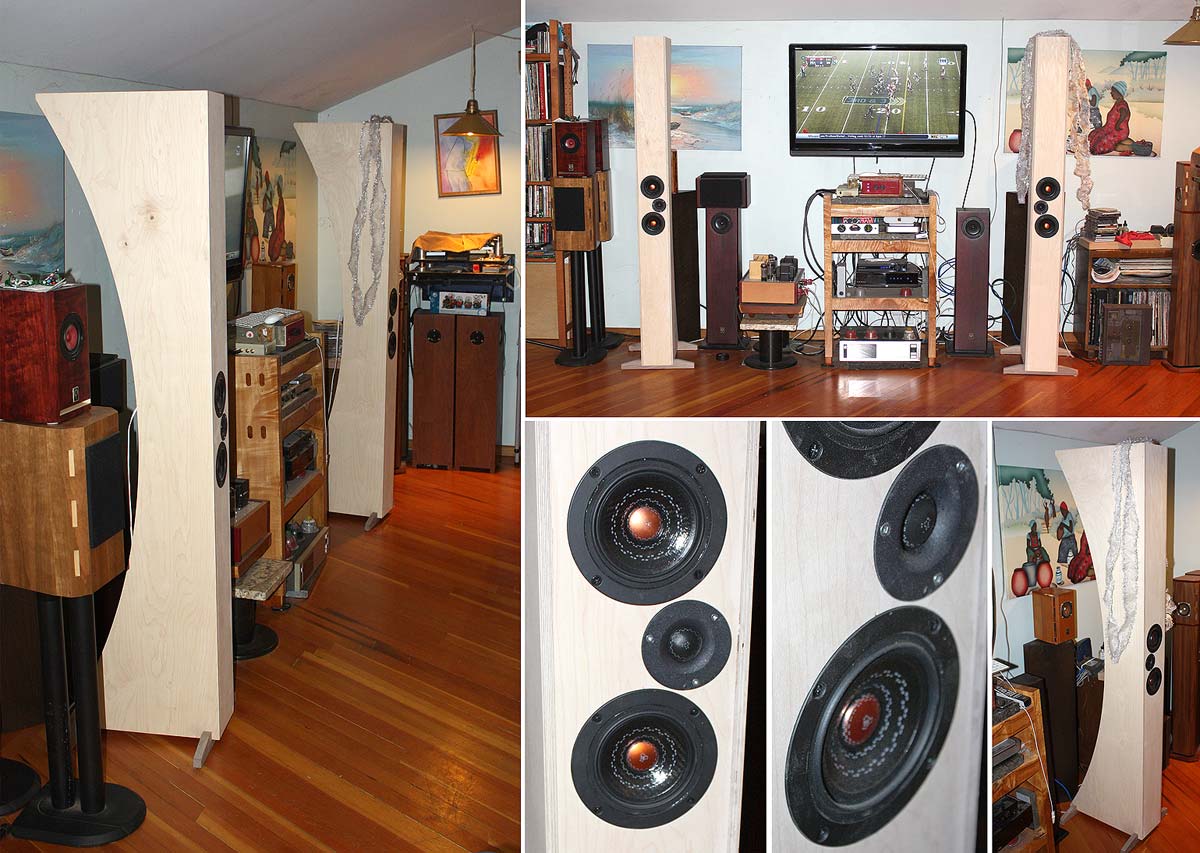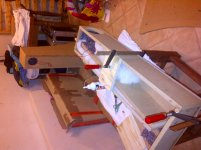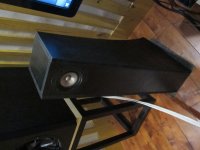... it just so happens that my Pensils and center have them...
Your Pensils have A7s in them, the bezel ring came from the factory already afixed, on all the others there was a choice.
dave
Originally Posted by cbiern http://www.diyaudio.com/forums/full-range/172605-frugel-horn-mk3-114.html#post3683663
The scallops being about 5/16" ?
As hard as it may be to believe, some details like this don't actually get measured, and I'd have to put a tape on them to be sure - I just set the router so that with the baffle face down, the center of the bearing on the 45dg bit rides on the "bottom" edge of the through hole.
Which, after I did a test hole, is the required 8mm or 5/16" of course! I'm so dense sometimes you could make speakers out of me! I like the pads. You don't have much material left after the chamfer and this way you get a little insurance.
Thanks for the tip.
Hey Chris,
What size of 45dg Chamfer bit would you suggest I buy for doing my Alpair 7.3 FH, 18mm BB with:
Cutting Tools - Router Bits Blue Tornado - Chamfer Bits - Busy Bee Tools
This bit may only ever get used for this project, but maybe I can find other uses for it in the future... making nice miter joints?
What size of 45dg Chamfer bit would you suggest I buy for doing my Alpair 7.3 FH, 18mm BB with:
Cutting Tools - Router Bits Blue Tornado - Chamfer Bits - Busy Bee Tools
This bit may only ever get used for this project, but maybe I can find other uses for it in the future... making nice miter joints?
Personally I'd spend more than $10 on a router bit for a task like this either Freud (40104 = 15mm 5/8" cut length), CMT, FS Tools or similar.
A 1/4" shank bit and small laminate trimmer would be perfectly fine for driver cut-out chamfers, but for mitre joints on approx 3/4" thick material, you'll need a "bigger gun" with 1/2" shank and router table. I use a CMT 836-950 - 1" cutting length.
A 1/4" shank bit and small laminate trimmer would be perfectly fine for driver cut-out chamfers, but for mitre joints on approx 3/4" thick material, you'll need a "bigger gun" with 1/2" shank and router table. I use a CMT 836-950 - 1" cutting length.
Point well taken Chris, most of my router bits are Freud.
The quality of the Busy Bee specials does not rival the name brand stuff like Freud.
But for jobs that will likely be a one and done, 10 bucks is better than
50 bucks sitting in the tool chest never to be used again.
The quality of the Busy Bee specials does not rival the name brand stuff like Freud.
But for jobs that will likely be a one and done, 10 bucks is better than
50 bucks sitting in the tool chest never to be used again.
Hello guys,
At first I needed some auratone mixcubes like boxes, to have a small reference, mid oriented, for my mastering studio.
And searching with full rangers, I found the Frugel Horn mk3. I was seduced by the concept of more heavier lows with horn loading. So I bought my flatpack and a pair of alpairs 7.3 !
I did put for the moment only 20g below the driver, will see with break in finished.
For the moment, it's a little low mid/bass heavy, but i'm only at ~20 hours of not at all loud listening.
At first I needed some auratone mixcubes like boxes, to have a small reference, mid oriented, for my mastering studio.
And searching with full rangers, I found the Frugel Horn mk3. I was seduced by the concept of more heavier lows with horn loading. So I bought my flatpack and a pair of alpairs 7.3 !
I did put for the moment only 20g below the driver, will see with break in finished.
For the moment, it's a little low mid/bass heavy, but i'm only at ~20 hours of not at all loud listening.
Attachments
...we will proceed with a stacked FH, in this case specifically targeted at the VRW MTM kit

Breaking in... promising.
dave
well you know there's always someone who thinks they need more, so proof of concept and all that.
essentially a pair of stacked FH3s without the angle - each of the VWRs in separate horn, with a little extra blocking at the separating panel to isolate the LDX tweeter
essentially a pair of stacked FH3s without the angle - each of the VWRs in separate horn, with a little extra blocking at the separating panel to isolate the LDX tweeter
Last edited:
funny you didn't comment on the Porsche reference
of course this is completely out of the thread's context - but this thing is rather fricking gorgeous for a hybrid , if you like that sorta thing
of course this is completely out of the thread's context - but this thing is rather fricking gorgeous for a hybrid , if you like that sorta thing
An externally hosted image should be here but it was not working when we last tested it.
- Home
- Loudspeakers
- Full Range
- Frugel-Horn Mk3


